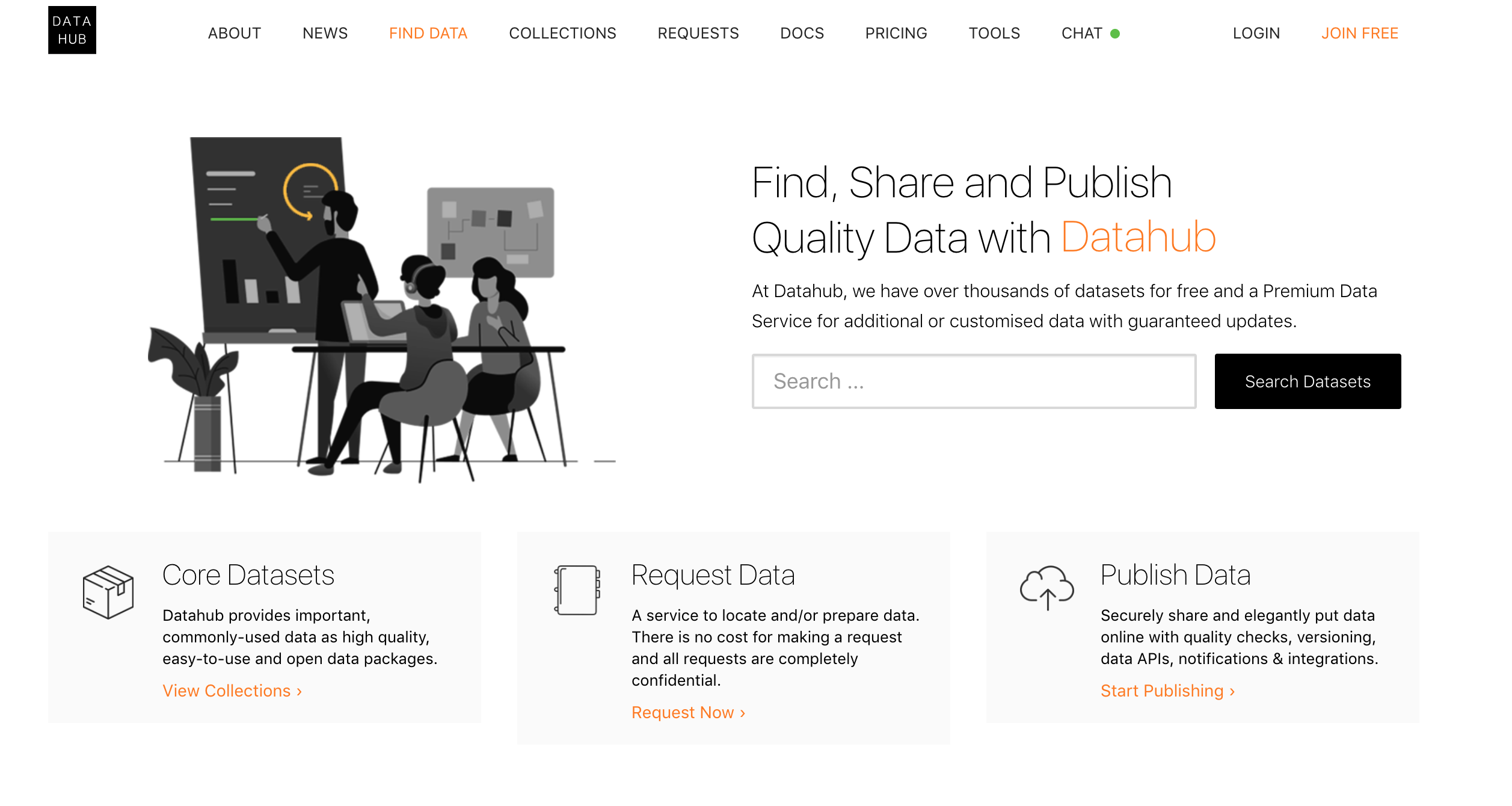Data Portal frontend. Designed for CKAN but usable anywhere. Microservice architecture so you can run and customize it standalone and connect to your backend of choice. Built in pure Javascript (Node).
Portal.js 🌀 is a javascript framework for building rich data portal frontends fast
using a modern frontend approach (JavaScript, React, SSR).
Requires node.js v8.10.0 or later
Clone the repo:
$ git clone https://github.com/datopian/frontend-v2.gitInstall project dependencies:
$ cd frontend-v2
$ yarn # or you can use `npm i`You can now run the frontend app in dev mode:
$ yarn dev # or `npm run dev`Open a browser and navigate to http://localhost:4000. If everything went correctly you should see the CKAN NG frontend app!
Now navigate to http://localhost:4000/search and you should see the data catalog - these are mocked at the moment. Let's now unmock it and use demo CKAN instance. To do that we need to change DMS API configuration. First stop the server and then run:
$ API_URL=http://demo.ckan.org/api/3/action/ yarn devNow you should see datasets from demo.ckan.org on your search page - http://localhost:4000/search.
Congratulations! You have a working data portal with live data backend!
Changing the appearance of the site is easy and quick - we suggest starting with the hello world tutorial.
Next step would be to check out the docs about how themes work in NG frontend.
By default, the app uses a config file named .env. We provide a template that you need to rename and edit:
$ cp env.template .envDescription of each variable:
API_URL- URL to the DMS backend API endpoint, e.g., if you're using CKAN Classic, it would be:ckan-domain.com/api/action/.NODE_ENV- this is just a node environment to indicate in which environment you are. If it is unset ordevelopment, the app will use mocked APIs. If you're working against live endpoint, set this config to, e.g.,staging.THEME- name of your theme.PLUGINS- list of space separated plugins, e.g., if you're using wordpress and dashboard:wp dashboard.REDIS_URL- Provide Redis URL for the production environment in order to store sessions related data on the Redis database.- TODO: other configs
When starting a server pass DOTENV_PATH environment variable to specify path to your .env. This is useful if you're running several projects and have a config file for each of them:
# Running my first project:
$ DOTENV_PATH=.project1.env yarn dev
# Now running my second project:
$ DOTENV_PATH=.project2.env yarn devBy default, the frontend runs against mocked API so you don't need to setup your own backend.
To change environment variables, you can rename env.template as .env and set the values. Here you can find more about configurations in Configuration section.
Setup API_URL environment variable so it points to your CKAN Classic instance, e.g., for demo.ckan.org it would be:
export API_URL=https://demo.ckan.org/api/3/action/
You can use one of built-in CMS plugins - check it out below.
Read about WordPress plugin here: http://tech.datopian.com/frontend/plugins/#wp
Read about CKAN Pages plugin here: http://tech.datopian.com/frontend/plugins/#ckan-pages
The frontend can be extended and customized. We saw in the Hello World section how we can use a custom theme to override site html using a views template.
In addition to html templates, you can add custom routes, additional middleware and more via plugins (and themes). Read more plugins in the plugins docs.
Themes and Plugins are actually very similar, for example you can create new routes or changes templates in both themes and plugins.
When do you want to create a theme and when a plugin?
- Plugins: functionality that applies to every request, regardless of what theme we are using.
- Themes: go for a theme if you are customizing the look and feel. You can also use the theme if you are e.g. adding routes and and you are just doing this for a single portal (and you don't intend to swap around between themes for this portal).
All of the controller and views MUST use the "API" modules, they don’t directly access the backend.
We have separated API module into DmsModel and CmsModel. The former part talks to CKAN (or can be any DMS), while the latter fetches content for static pages, for example, it can be WordPress. Below is the flow of how it works together:
sequenceDiagram
Browser->>Controller: /
Controller->>Browser: home.html
alt Exists in CMS
Browser->>Controller: /about
Controller-->>CMS: slug=about
CMS-->>Controller: found: page content
Controller->>Browser: static.html
Browser->>Controller: /news
Controller-->>CMS: slug=news
CMS-->>Controller: found: list of posts
Controller->>Browser: blog.html
Browser->>Controller: /news/my-blog-post
Controller-->>CMS: slug=my-blog-post
CMS-->>Controller: found: post content
Controller->>Browser: static.html
end
alt Not Found in CMS
Browser->>Controller: /search
Controller-->>CMS: slug=search
CMS-->>Controller: not found: 404
Controller-->>DMS: search api
DMS-->>Controller: result: list of data packages + summary
Controller->>Browser: search.html
Browser->>Controller: /org/gdp
Controller-->>CMS: slug=org/gdp
CMS-->>Controller: not found: 404
Controller-->>DMS: getPackage api
DMS-->>Controller: result: data package
Controller->>Browser: showcase.html
end
Here is the summary of existing routes at the moment:
- Home:
/ - Search:
/search- with query:
/search?q=gdp
- with query:
- Showcase:
/organization/dataset - Organization:
/my_org- It gets redirected from CKAN like path:
/organization/my_org
- It gets redirected from CKAN like path:
- Collections:
/collections- It gets redirected from CKAN groups page:
/group
- It gets redirected from CKAN groups page:
- CMS:
- About:
/about - Blog:
/news - Post:
/news/my-post - Anything else:
/foo/bar
- About:
Set .env to hit mocked services:
API_URL=http://127.0.0.1:5000/api/3/action/
WP_URL=http://127.0.0.1:6000Run tests:
yarn test
# watch mode:
yarn test:watchYou can deploy this app to any host that supports NodeJS.
Read the docs about Deployment of NodeJS apps on Heroku - https://devcenter.heroku.com/articles/deploying-nodejs.
Read the docs - https://zeit.co/examples/nodejs
Suggested config file (now.json):
{
"version": 2,
"builds": [
{
"src": "index.js",
"use": "@now/node-server",
"config": { "maxLambdaSize": "50mb" }
}
],
"env": {
"NODE_ENV": "development"
},
"routes": [
{
"src": "/(.*)",
"dest": "/index.js"
}
]
}